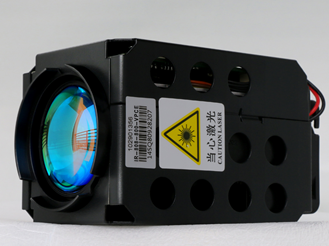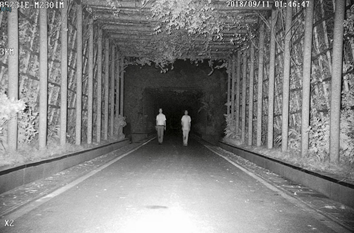
Applications
Infrared laser light is a night-time auxiliary lighting device specially designed for camera monitoring system. A high-power infrared laser is emitted from an infrared semiconductor laser diode. The laser spot size is controlled by the beam-combination mirrors. Therefore, the target can be illuminated within a certain range. The camera can sense infrared imaging and night vision monitoring is achieved.Infrared laser light system is generally composed of infrared semiconductor laser diode, infrared laser optical processing element, intelligent control module, and heat dissipation module. Infrared laser light system and infrared camera or CCD monochrome camera system form an intelligent night vision monitoring system.
For the passive imaging and measurement systems with natural light illumination, it is very limited for the ability of high-definition imaging and accurately tracking targets due to the various background radiation effects. However, the laser active illumination method can completely solve these problems. The infrared laser light can actively illuminate those targets or their parts no matter how far, how small or how dark the target is, and the influence of background radiation is also greatly weakened. So, it is significantly improved for the system's capabilities of precise tracking and clear imaging.
The laser active illumination monitoring system works in much the same way as a laser radar. The target can be illuminated by adjusting the focus state of the emitted laser beam, ie the divergence angle. The surface of the scene reflects the infrared laser onto the infrared camera to form an image, accordingly, a clear imaging is achieved and precise tracking of the target is realized. In the end, video surveillance equipment can obtain clear and detailed high-quality night vision images at long distances ranging from a few hundred meters to several kilometers in a completely dark environment. In addition, atmospheric background radiation, transmittance, scattering, absorption, and turbulence will all have effects on active illumination imaging during the emission and reflection of laser light transmitted in the atmospheric path.
The laser light emitted by the semiconductor laser diode is very suitable for long-distance illumination because the divergence angle of laser is small, energy is concentrated, and there is still a sufficient light intensity propagated to a long distance due to the good directivity of laser. Illumination of long-range targets is the most important feature of infrared laser illuminators.
Infrared VCSEL have great advantages over edge-emitting infrared lasers for the application of Infrared laser light.
1. VCSEL can accommodate large temperature differences in different outdoor environments and seasons due to its wider operating temperature range than ordinary edge-emitting laser diodes. VCSEL have lower thermal redundancy, so that the temperature during normal operation is only a little higher than the ambient temperature. In addition, the VCSEL emission spectrum and optical power are less dependent on temperature. For example, the VCSEL has a wavelength coefficient of only 0.07 nm/℃.which is much lower than 0.3 nm/℃of a typical edge emitting laser. Therefore, natural air cooling can be enough to ensure the normal operation of the VCSEL light source. However, the conventional edge-emitting infrared laser lamp has a narrow operating temperature range, high thermal redundancy, and high sensitivity to temperature, so it must be equipped with a laser cooling module, and even needs to be preheated in the extremely low temperature environment in winter. When applied on an drone, the VCSEL not only simplifies its heat dissipation structure, but also reduces the cooling module, resulting in a smaller size and lighter weight.
2. Furthermore, the laser homogenization technology of the VCSEL is unique, which is completely different from the laser homogenization technology used by rotating the frosted glass for the conventional edge-emitting infrared laser diode. The VCSEL adopts a microlens to achieve laser homogenization, which has no motor, no vibration and no light loss. This method not only saves the space, weight and power dissipation required for the laser homogenization module, and also avoids the vibration when the motor continuously rotates. As a result, the stability and clarity of the drone surveillance camera is guaranteed.


